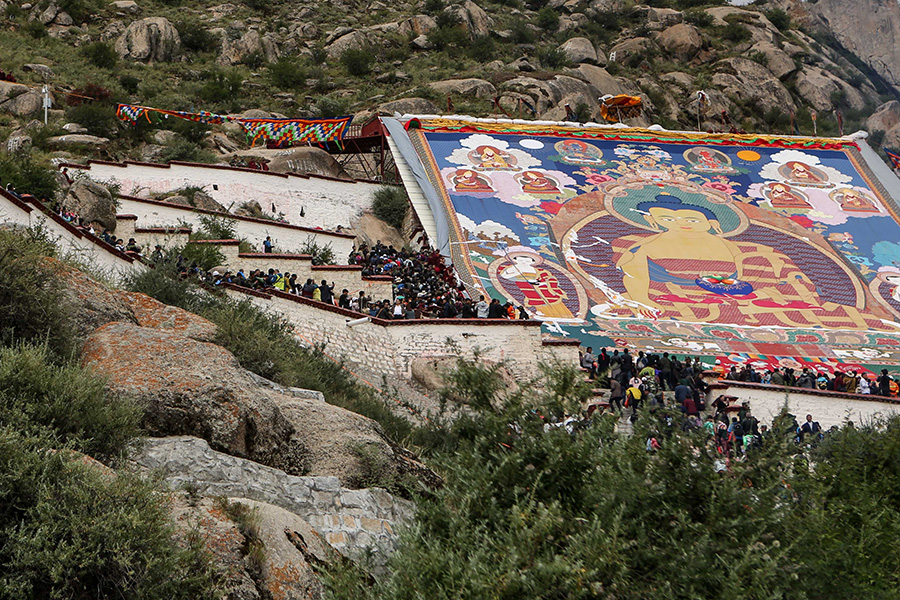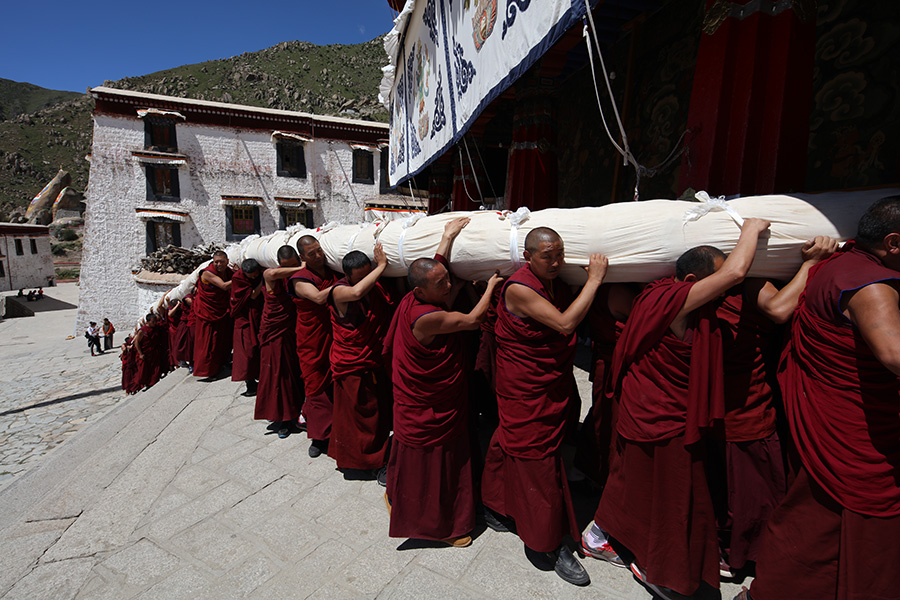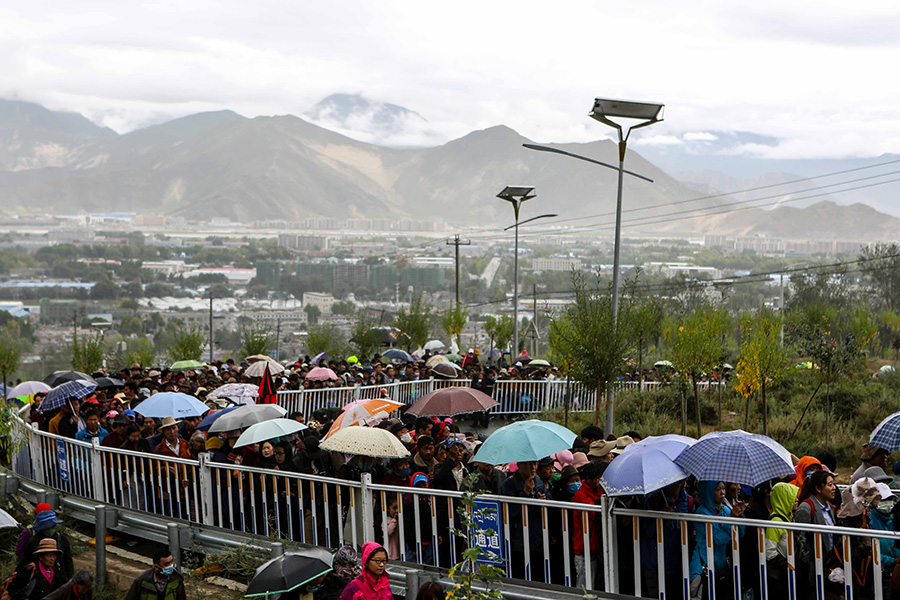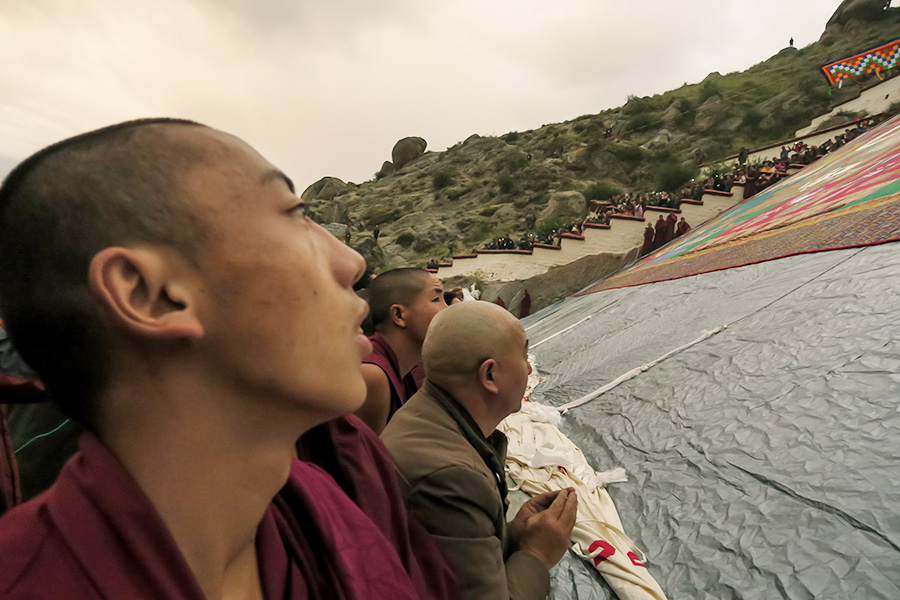DepthReading
Witnessing the Buddha's unveiling
 |
A huge thangka portrait of Shakyamuni Buddha is unfolded on a hillside behind Drepung Monastery in Lhasa, as one of the highlights of the Shoton Festival. [Photo/VCG] |
It was a dark and rainy morning in the Tibet autonomous region, but my traveling companion and I could not sleep. The clock had not yet struck 4 am as we clambered out of our beds and prepared to make our way to the Shoton Festival, one of the region's largest annual celebrations.
A friend had advised us to get an early start if we wanted to secure a spot for the "sunning of the Buddha" ceremony, which marks the start of the festival at the Drepung Monastery on the outskirts of the regional capital, Lhasa.
We already considered ourselves lucky that our vacation coincided with the opening of the festival, so missing the unveiling of the 500-square-meter thangka, a religious silk embroidery or painting that is unique to Tibet, was unthinkable.
First we took a cab and then we walked, for about 40 minutes, to the foot of the hillside where the image of Buddha would be displayed.
The night was reluctant to recede and the rain refused to stop, so I put on my cowgirl hat that I had bought the previous day on Barkhor Street-Lhasa's best known shopping area-to protect myself from the elements as we walked on in silence, under the cloak of night.
Some Tibetan women joined us as we trekked, carrying children wrapped in papooses tied to their backs. There was also a group of foreigners, clattering along the trail on their bicycles with flashlights strapped to their heads.
Finally, we arrived at the foot of the hill, but were told it would cost 60 yuan ($8.70) each to go any further. This entry fee only applies to tourists. Ethnic Tibetans can attend the ceremony for free.
 |
Lamas carry a roll-the giant portrait-on their shoulders as they walk up the hillside behind the monastery. [Photo/VCG] |
A long, cold wait
The road, if you could call it that, had suddenly become steep and slippery. We moved at a snail's pace toward the large open slope where the image of Buddha would be revealed. It was entirely covered by what appeared to be a giant plastic sheet.
There was already a throng of bystanders up there, perched atop any vantage point they could reach. It seemed every patch of open ground had been claimed by someone already, but I was sure there would be space for one more person, or even two. After the early start and rainy trek, we were determined to settle for nothing less than an unimpeded view of the action.
After the initial excitement, the waiting began. It was already 4 am, but the rain was still falling and we had to wait for it to stop.
A middle-aged lama, as Tibetan Buddhist monks are called, was sat on a nearby rock casting thoughtful looks in our direction.
There were Tibetan women to either side of me, with their dark skin and braided hair. Despite all the waiting, they showed no signs of fatigue or impatience. Behind me, my traveling companion could hardly get a foothold on a sodden patch of rocky ground.
Two hours later and with no signs of the rain abating, a little stream began to form where I stood. The lama, despite that imperturbable look he wore, had already stood up, while from a bundle on one of the women's backs came the sound of muffled crying.
I was on the brink of tears myself: It was cold, I was hungry and had to endure the occasional "why-are-you-even-here" look from those around me.
Even without my friend nudging me from behind begging for us to go, I would have considered leaving-but for the fact that there was no way out. Looking down, the entire hillside was carpeted with people.
Just as I was about to give up hope, the rain eased off. It didn't stop completely until after the ceremony, but no one could wait any longer-even the lamas.
 |
A large crowd of pilgrims and tourists flocks to the monastery in spite of the rainy weather. [Photo/VCG] |
The procession begins
As night gave way to day, a row of figures emerged atop the hillside and a golden canopy was set up for one of them, who I presumed would preside over the ceremony. Yet while I was struggling to focus my sore eyes on what was happening above, there was a sudden flurry of activity below.
Two lines of lamas, carrying a giant roll of material on their shoulders, began marching slowly up the winding track from the monastery.
I was informed by someone standing nearby that the roll, once fully unfurled, would form a giant portrait of the Buddha.
Marching in front of the procession were standard-bearers carrying red and golden streamers, while from behind came another two lines of lamas, carrying another roll. From where I was stood, I could catch only a glimpse of them in between the backs of heads and they soon disappeared completely from view at a bend in the track. The next time I saw them, they'd arrived at the foot of the big slope.
At the sight of the procession, the crowd surrounding me became ecstatic, falling over themselves to reach out and touch the streamers, believing them to bring good luck. The lamas, struggling through the assembled masses, had a tough time keeping their towering hats upon their heads.
Punctuating the atmosphere was the solemn sound of a wind instrument, resonating back and forth along the hillside. Although the rain had stopped, the morning mist had yet to dissipate and it filled up every crevice of the landscape, mingling with the sound.
It would have been serene, if not for the bustle of the waiting crowd. As the anticipation built, all the yawning and fidgeting gave way to a number of last-ditch attempts by some to reposition themselves, in a bid to steal a better vantage point before the ceremony took place.
 |
[Photo/VCG] |
The Buddha revealed
Apparently unperturbed by the chaotic scenes that surrounded them, or simply preoccupied with their own duties, the uppermost lamas began to throw balls of rope down from the top of the slope. As each fell, it quickly unraveled, with the ends being snatched up by waiting hands at the bottom. Some lengths of rope stopped midway and had to be encouraged in their descent by a forest of arms that emerged from the middle of the plastic sheet, shaking at it furiously.
I couldn't see what happened next exactly, but it seemed that the ropes were being attached to the portrait of the Buddha-the giant roll I'd seen being carried aloft before.
Suddenly, the lamas at the top of the slope began heaving on the ropes and before I knew what was happening people started to scream in ecstasy. The portrait of Buddha was being revealed right in front of my eyes!
First came a giant piece of yellow cloth, covered in scripture. Next, as the lamas at the top of the slope continued to pull on the ropes, what appeared to me to be the lower half of the Buddha came into view. It was at this point that the portrait stopped moving upward, and the yellow cloth was gradually lifted up to reveal the Buddha's upper half.
And there he was-Shakyamuni Buddha-sitting cross-legged and gazing into the distance. It was only later that I realized the second roll of material I had seen being carried up the hill was in fact the yellow cloth covered in scripture. This made sense, as Tibetan Buddhists believe that all statues and portraits of the Buddha must be accompanied by holy text.
It had only taken a matter of minutes for the portrait to be unveiled, yet we had waited for it for four hours. As a non-Buddhist, I started to question whether the wait had been worth it, but I thought to myself that it was certainly humbling to be a part of the largest Tibetan festival on Earth.
 |
[Photo/VCG] |
A vortex of humanity
My reverie was unexpectedly broken then by a hard shove in the side, and I realized the ceremony wasn't quite over yet. It may have been for me, as there wasn't much left to see, but for the believers, it had only just started-they were in the presence of the Buddha now and it was time to pay their respects.
Some in the huddled crowd had hurled their hada (a long piece of white silk Tibetans routinely present to honored guests) at the portrait of the Buddha while it was still ascending. But most, especially those who had been standing farther away, took this opportunity to shuffle forward and attempt to lay theirs at the foot of the portrait in person.
As devotees struggled forward and backward, up and down the slope, I became hopelessly caught in a vortex of humanity. Unable to resist the tide of people coming their way, one tourist couple wore frightened looks and their daughter wept slightly over her father's shoulder, apparently too scared to look up.
It took about a quarter of an hour before the turmoil ended. On the way back, I saw numerous little mounds of smoldering ashes-from the burning of grass-and people standing on both sides of the road with armfuls of unsold hada.
Before taking the final turn in the road that would block the mountain from view, I stopped to give the Buddha one last look, and to say goodbye.
I saw people wearing exhausted expressions still streaming down the hillside. Farther away were two giant rocks with colorful Tibetan characters on them that read "Drepung Monastery". And even farther away, in the far background, I saw the portrait of the Buddha, strewed with white bands. The fog had finally dispersed.
If you go
Lhasa, capital of the Tibet autonomous region, is a four-hour flight or 40 hours by train from Beijing. Originating in the 11th century, the Shoton Festival mainly consists of three parts: the "sunning of the Buddha", a Tibetan Opera show and a horsemanship and yak race show. It takes place every year around September (or early in the seventh month of the Tibetan lunar calendar) at Drepung Monastery, located at the foot of Mount Gephel in the western suburbs of Lhasa.
Shoton is a transliteration of two words in the Tibetan language that mean "the yogurt banquet".
Category: English
DepthReading
Key words:
